Fatigue is the enemy of travelers: in addition to the added stress it induces, it kills one’s perceptions and judgment, blurring the lines of Known Habit with those of the New Worlds one has set out to seek.
And yet, it’s with just a few hours of rough sleep, bumped around in a night bus, that we disembark at dawn in Banaue, Philippines, little aware of the magic that’s about to unravel.
Threads of mist slide past the mountainside; the sleepy mountain village lies at rest. A few other tourists tiredly lug their hefty backpacks and clamor towards the town square, eager to cap their night.

Banaue
A local man with a wide red smile, one that reveals his set of teeth stained by the blood-like juice of betel nuts, or areca nuts, greets us to the area. Unsure what to do next, or whether to trust him, I interview him. The fellow’s answer puts me more at ease. He offers his tricycle to take us to the nearby rice terraces of Batad. This alternative is much cheaper than hiring a full-blown jeepney. Besides, there’s nobody else in sight to split the cost of the jeepney.
We hop in, once again happy to be carrying only small backpacks, and within seconds the tricycle is rattling down the slopes of Banaue, then past the wood shacks and stray dogs, into the countryside. Coco and I feel alive, and lost, and alive because we’re lost. Who knows where this will end?
The Trike: From Banaue to Batad
The cool morning air, coupled with the dizzying turns of the tricycle, has us soon wide awake, and entranced, as we roll by one rice terrace after the other. Our chauffeur kindly brakes at a viewpoint, and we take in the unique sights, high off life.
Within half an hour, or who knows how long, the trike putters at the foot of a steep, muddy hill. We’re informed that we’ll have to pursue the journey on our own, a two-or three-mile uphill hike, and hardly one of the prettiest (so hiring a jeepney instead of a tricycle does in fact have its benefits…).
Our morale is untarnished. So be it. It’s not yet 7am: we convene to meet our driver at the top of the hill upon our return, early afternoon (the tricycle can make it up the hill with one driver, but not a full payload). The motorized vehicle dashes off around a bend into the distance.

Rice terrace viewpoint near Banaue on the way to Batad.
From a nearby, solitary woodshack emerges an old lady with fair skin and clear blue eyes. With her slow manners, she carries the wisdom of the Earth. I attempt to pry some information.
“The story of Batad is long… If you want to hear it, you must stay.” She suggests we rent two walking sticks.
We thank her for the walking sticks and begin the steep, unfriendly ascent. Fortunately, we’re in luck. A jeepney soon makes its way up the hill, and we hitch a ride with a few locals. It quickly becomes obvious we wouldn’t have lasted long had we elected to walk the whole distance – for the lost rice terraces of Batad are still miles away from the top of the hill, and accessible only by foot.
We descend at the drop-off point. There’s a small grocery shop. A lone vendor. That’s about it. Coco and I retreat to a secluded corner to ponder. From where we stand, the valley stretches below, covered by thick clouds. I’m simply hoping they will clear, as to avoid the mild disappointment previously experienced when visiting the rice terraces of Longshen, in China.
I propose that we store one of our backpacks with the grocer here, and transfer all of our valuables into the other. That being done, we’re at a crossroads. The fog remains thick, and the path is invisible from where we stand. It’s hard to judge its accessibility. Coco is ill at ease descending into the unknown. Though I’ve an inkling we can do it on our own, truth is, I can’t be sure.
Luck helps, and this time it takes the shape of a small group of four or five early-rising tourists who make their way up in a jeepney, accompanied by a local guide. I wonder if we can follow them down, offering to split our share of the guide fee if need be. Not everybody’s enthused. So the plan falls through.
Another ‘guide’ offers his help. As is almost systematically the case in small communities, the locals are closely bound by the communal agreement to maximize tourists’ dollars. We bargain, I cave in, disappointedly.
The Hike: Batad’s Rice Terraces, Climbing Down And Up
Our two groups make our way towards Batad. This is our first somewhat substantial hike during this trip. Coco is not accustomed to hiking – to the contrary. Her fear of heights makes any downhill movement a tricky business.
As I’d suspected, the trail is straightforward and not the least challenging. I immediately regret our pseudo-guide, who trots down, hands in his pockets, lured by the promise of a few bucks.
After some time, a sign beckons us into Batad, revealing some houses and the first signs of rudimentary hotels.
On a side note, most tourists visit Batad on a day-trip from Banaue, returning to the transport hub at night. As such, Batad’s community is deprived from this seemingly much needed source of income, and its trade relies almost solely on local ‘guides’ – everybody, including children and the elderly, offers their services. But beware of their wrath and misdirection should you opt to do it on your own, as we shall soon see for ourselves!
(Word of advice: if you can stay there for the night, please do so. The setting has no equal, and waking at dawn to watch the mist unveil the valley must surely figure in the list of the world’s most wonderful wanderlust experiences.)
I’ll omit the description of the panorama that welcomes visitors into Batad, of the small village hovering above the bowl-shaped rice terraces, their sprawling expanse leaving an unforgettable print into one’s memories: words would be lacking.
But the ‘real’ hike hasn’t even started yet, as we must still cross the valley’s terraces, to reached a promised waterfall. We rest and drink, I buy some butter biscuits. We’re sleep-depraved, and haven’t eaten. And we have a long, exhausting walk ahead.
It’s now clear we’ve miscalculated the duration of the hike, and that we won’t return in time to meet our tricycle driver. I wonder how we could warn him, remember the interview at dawn and produce the footage: our guide claims to recognize him. I insist that he call him to postpone our pick-up. He says he will do so.
Frustrated that we’ve had to resort to an unnecessary guide, and eager to do the rest on our own (just for the sake of it) I wonder whether we should send him off. The path into the valley, through the rice terraces, seems easy enough. A grave misperception…
The other group of hikers soon catches up, and follows their guide downwards. I’m still hesitant. The final decision is primed by a lone Japanese hiker, who’s obviously experienced. He comes trudging down, asks a few directions, shoos off the locals’ repeated offers to guide him, and disappears into the valley. (We’ll later learn that, in exchange for a comic book, a dollar and some candy, he bargained with a group of kids to show him around).
Sidenote: Though I admire this DIY spirit, and would probably have opted for a similar approach had I been on my own, in retrospect I’m left to wonder whether, in the long run, this behavior positively impacts the local population, in this case school-less children, who thus become first envious, then dependent upon, the meager resources brought in by tourists.
But as to the answer to those questions, that I will leave to you, fellow travelers.
Thus I send our guide off, despite his disappointment. I pay him the full amount due, but I suspect his pride is wounded. Neither him nor Coco are happy with this decision.
He watches us off with a shrug and a curse. We walk on the path past a few houses but we’re rapidly faced with an exponential tree of tiny paths that all windingly lead down the mountainside past trees, bends and houses, equally inscrutable.
Adding pressure, every local dutifully asks the same question:
“Do you need a guide?”
We clench our teeth and continue downwards. After some entangled minutes, we reach a rice terrace as the path opens onto the vista. The view is amazing, but we’ve got a problem. Problem? No problem!
In the distance, already at the foot of the valley, the guided group is making its way. And we’re stranded on a lone rice terrace, fifteen feet above the next. The situation is bleak.
Worried about Coco’s wrath, I gently instruct her on the following proceedings: we’ll have to walk along the edge of the terrace, a narrow set of rocks set by hand, then climb down each terrace, lugging walking sticks, backpack and all, using the miniature staircase at our disposal, nothing more than stones unevenly protruding from the wall.
And thus we continue.
(During our perilous descent, we make way for stone carriers effortlessly heaving boulders over their heads, trotting down the stone staircase.)
Further challenges omitted, we make it down the valley, past a lone village, a drunkard shouts nonsensically. The other locals direct us kindly, but not without a tint of frustration at the repeated passage of hikers.
Hours have passed by the time we make it to the top of the hill on the other side of the valley. We rest and take in the view. A young lady entrepreneur has intelligently set up shop with much-needed bottled water.

Batad rice terraces
Drink, eat some biscuits. Coco’s burnt by the stress and fatigue. The hike winds further down, steep and slippery, to the waterfall.
After much moaning, whining and grinding, all of which make me feel like a tyrannical beast, past a river horse-shooing around the mountain, we can hear the roaring splatter of the waterfall. Coco’s eyes are teary.
I waste saliva trying to convince her to make the last steps to the foot of the cascade: How often do we get to see such a thing, let alone have the privilege of witnessing it on our own?
We’re at last rewarded with a moment of special beauty: hundreds of feet of water gushing through the trees and mountain, through the sun’s sloping rays, into a translucent basin.
What was previously a mild downwards walk now proves to be brutally physical on the way back up, after a day of hiking, carrying a backpack, and with little more than a few biscuits and a half-night’s sleep on the bus.
Carolina Jones is vaillant the whole way up: I watch her precede me along the edges of the rice terraces, using the walking sticks to keep her balance – who at this time could guess she has advanced fear of heights?
Several times my head goes faint and I breath in calmly to avoid tragedy: juggling the task of performing various photo and video perspectives while walking on a ten-inch ledge can be tricky on spatial perception.
We make it back to Batad just in time to catch up with the guided group as it’s about to return to the top of the hill. We haven’t resolved our return situation, and they’re our only hope of transportation should our tricycle driver be absent.
After rapidly consuming our last goods in Batad, and breathing in the last of this incredible, once-in-a-lifetime view, we pick up our woes and very nearly sprint upwards to catch up with the group.
—
The last of the harrowing steps, and we’ve made it to the top. Just as the clouds gather heavily above. Our tuk-tuk driver has been dutifully waiting there, I apologize profusely, he didn’t get the message from our irked guide. The downpour begins, tropical, torrential.
Among the commotion, another other couple hops in with our tuk-tuk driver, we hop into another.
Just in time.
The rain is pouring in droves, and the wheels slush through the mud roads, barely discernable. An exhilarating end to an exhilarating day.
Several times our driver adjusts for dead-dangerous turns, and we make it back safely. Upon our return to Banaue, soaked and ecstatic, I spot the initial driver and reward him for his wait.
We still have no hotel reservation, and head to a low-key lodge set to the edge of the town square. Cheap and minimal – euphemism; after some food and a well deserved hot shower we rapidly fall into well-deserved eternal slumber.
—
The next morning, sitting on the balcony warmly overseeing the valley. The fog snakes slither by. A German hiker shares this peaceful time. He has several tattoos, including one that looks fresh, black and scarry.
“I walked that way, to the next village. Very nice. No people there. The ladies there, they did this.”
“You stayed overnight?”
“Yes. I had dinner with the family and then I slept on the floor. It’s much better that way. You get to see the less visited places. They’re not used to seeing tourists.”
—
See the photos and video from Batad & Banaue Rice Terraces.
Or read more on RollingCoconut.com for travel tips on visiting the Philippines and Banaue & Batad Rice Terraces!

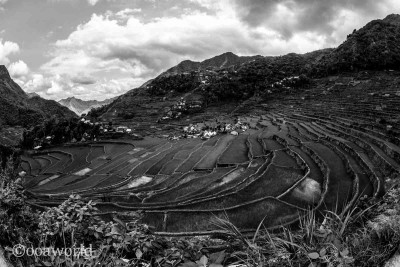
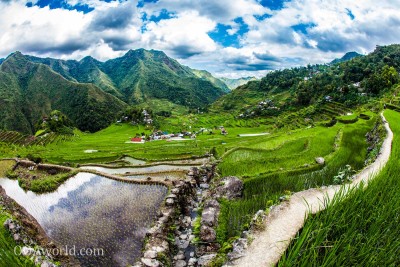
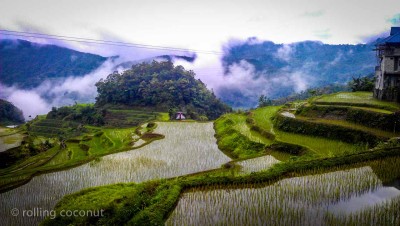
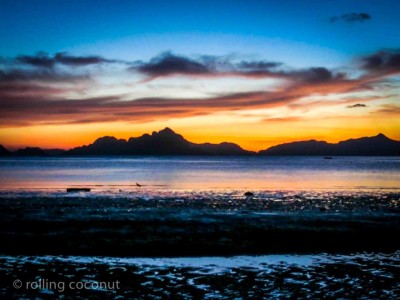
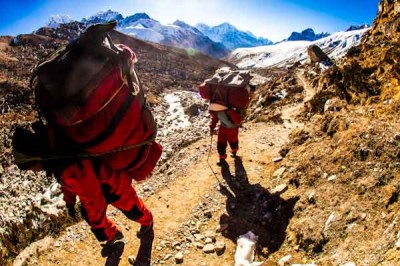
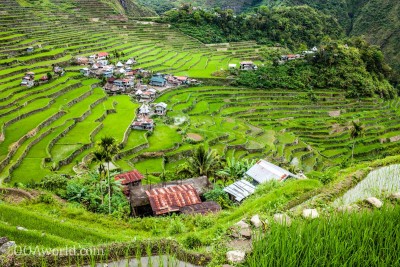
4 Responses
[…] for sharing! You may also be interested in reading the story from Banaue and Batad’s rice terraces, or other posts from the […]
[…] for sharing, you can also read the story and see the travel photos from Banaue & Batad Rice […]
[…] for sharing! You may also be interested in reading the story or watching the video from Banaue and Batad’s rice terraces, or other posts from the […]
[…] Go to http://www.ooaworld.com for more photos, videos and stories on visiting the Philippines and the Batad Rice Terraces. […]